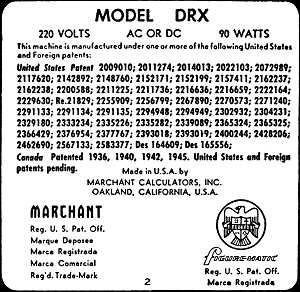 The Figurematic Patents.
The Figurematic Patents.
The patent label attached to the underside of the Marchant DRX lists over fifty patents and registered designs which apply in greater or lesser degree to the machine described. The patents are essential reading for anyone seeking to understand the mechanisms in greater detail than the overviews presented here.
The patents contain a wealth of technical drawings and written descriptions which explain the intent, the operation, and the subtleties of the mechanisms in infinite detail. They provide a fascinating insight into the history and development of the "Silent Speed" family over a period of about 20 years.
About a dozen of the patents on the DRX label actually relate to principles or mechanisms from the "old-line" machines, which were carried over and adapted for use in the Silent Speed and Figuremaster families (for example, the modular keyboard, and the multiplier which processes its inputs "on-the-fly" ). Two or three of the patents describe complete machines, while the remainder deal with improvements to particular sections of the mechanism. Some of the sections were "improved" many times over.
This page highlights some of the more interesting items from the complete list.
2009010, July 23 1935 (9 pages)
The first patent in the list, relating to a powered carriage shift
mechanism, was submitted by Carl Friden in March 1927.
Friden was a Swedish engineer who was the inventor and principal
developer of the modified-pinwheel machines
that were built by Marchant from the early 1920s (the "old-line"
machines). Friden held many of the early patents in his own right.
He sold his interests to Marchant in 1928, but continued as a
consultant for a short period. His last appearance in the list is
in patent 2011274, submitted jointly with Gustav Lerch in 1930.
Friden set up his own company in 1933 in order to build
a new line of calculators under his own name.
2157411, May 9 1939 (51 pages)
This patent application was first submitted by George W Hopkins Jr
in 1928. It was abandonned and later resubmitted, assigned to the
Marchant Calculating Machine Company, in May 1931. The patent
describes a large and elaborate calculating machine "attachment" for
a Burroughs-style adding machine, and appears at first sight to be
totally unrelated to the Marchant product line. Closer reading shows
that Hopkins' patent covers one of the key features that would later
be used in the Silent Speed family - the predictive trip mechanism
for automatic division, based on the sensing and comparison of
values in a movable register.
2229630, January 28 1941 (47 pages)
This patent is the first complete description of the "Silent Speed"
mechanism, submitted by chief designer Harold Avery in January 1933.
Avery's first appearance in the list is in patent 2200588 (31 pages),
submitted in October 1926 for an automatic division control system
for the "old-line" machines. He is listed as the sole inventor in all
of the Silent Speed patents from 1933 to about 1940. Several new and
different names are listed in the applications from 1941 to the last
(2583377) in 1947. Patent 2229630 describes how the Silent Speed
mechanism aims to reduce noise and increase speed by eliminating
detents and intermittent operations. The setting mechanism, actuator,
and accumulator from 1933 are very similar to the Figurematic of the
1950s, although the controls and clutches have changed significantly.
2271240, October 1 1940 (75 pages)
This patent for improvements to the Silent Speed mechanism was
submitted by Harold Avery in June 1936 and issued in October 1940.
The patent contains a very detailed description of the operation
of the Silent Speed mechanism as it stood in 1936, including the
automatic multiplier and the division controls. This is the last
full description of the entire machine among the patents listed.
Subsequent applications deal only with specific improvements,
although there is a lot of overlap in the descriptions.
2333234, November 2 1943 (11 pages)
This patent for simplification of the Silent Speed clutch mechanisms
was submitted jointly by Robert Boyden and Harold Avery in 1941. In
the original design, the setting clutch made only half a turn per
machine cycle (as did the main clutch). A separate clutch on the
number 4 shaft handled the "restore" functions at the end of the
cycle. This patent deleted the restore clutch and replaced it with
the two-stage rotation of the setting line. The space released on
the number 4 shaft was later filled with the Clear/Return clutch.
2400244, May 14 1946 (21 pages)
This patent, submitted by Walter Mathi in 1941, gives a detailed
description of the mechanism and the control unit logic for the
Figuremaster high-speed multiplier. Mathi had previously appeared
in the list in an old-line patent (2117620) from 1931.